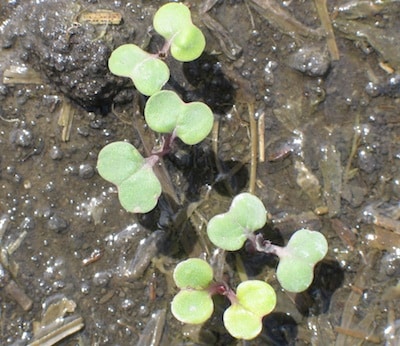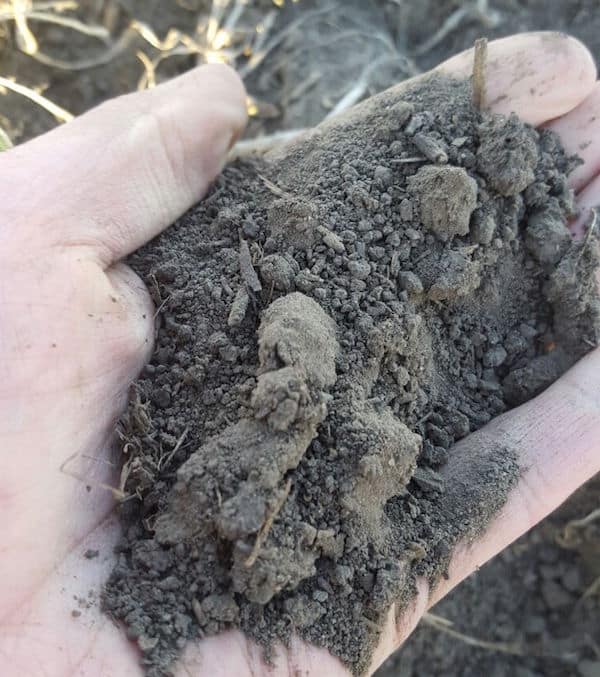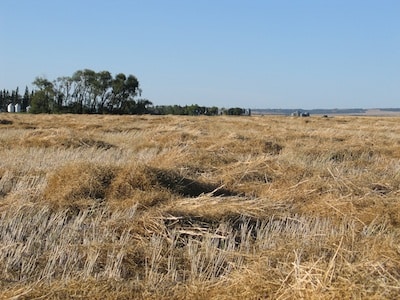Crop yield has a lot to do with weather — rainfall, temperature, frost and hail are the biggies. Agronomic steps to reduce weather related risk can go a long way to help canola achieve higher yields under stress.
5 general weather-proofing steps
1. Find varieties that yield well consistently in a broad range of conditions. Canola Performance Trials are one source of information.
2. Seed in May, and ideally early to mid May. This timing strikes the best balance to reduce weather risk, based on historical averages, and reach yield potential.
3. Achieve a plant stand of 5 to 8 plants per square foot. This provides a buffer if a few plants are lost to weather stress.
4. Take steps to maintain good soil health. This improves soil moisture holding capacity. Healthy plants with ample nutrition from a balanced and even aggressive fertilizer program are more resilient to stress.
5. Use crop insurance. Crop insurance programs are government subsidized to reduce costs to growers, providing economic protection again weather-related risk to yield.
Select the weather issue you’re dealing with:
Cold spring soils
Late spring frost
Excess moisture
Drought
Summer heat
Mid-season moisture
Hail
Early fall frost
Wind
Cold spring soils
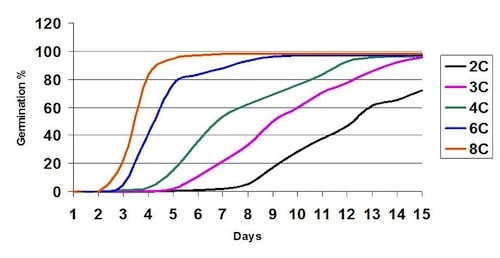
Seeding early is proven to increase yield, but seeding too early into cold soils can greatly reduce stand establishment. Canola seed can germinate in soils as cool as 2°C, but germination rates will be lower and spread out over a couple of weeks.
Agronomy tips:
—Seed shallow. Canola grows slowly in cool soils, so shallow seeding will reduce the time to emergence and reduce stress. Aim for 1/2″ to 1″ depth.
—Seed-placed phosphorus can help get the crop moving early and more evenly under cool soil conditions. Why limit other seed-placed fertilizers?
—Considering waiting, especially if seeding into cold soils in April. By mid May, soil temperature becomes a lower priority. Seeding into warmer (8-10°C) soils will improve seed survival and have more seed emerging at the same time (as shown in the graph) but by mid May, yield benefits of early seeding trump soil temperature.
Late spring frost
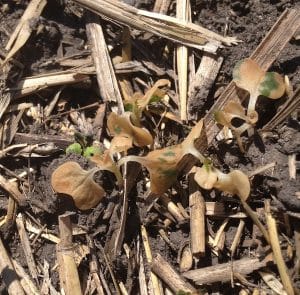
Spring frost can thin a stand significantly. In 2015, Western Canadian canola growers reseeded 1,623,086 acres, with frost a leading reason. Later seeding will greatly reduce the spring frost risk, but late seeding increases the risk of summer heat loss to flowers and increases the fall frost risk. On average, canola yield is lower for later seeded crops.
Agronomy tips:
—Look at the historic record of last spring frosts for your area. This will help you determine whether late April, early May or mid May are your best times to start seeding.
—Canola that emerges in cooler conditions may be more tolerant of frost. These canola plants are acclimatized — or “hardened” — to cool conditions. Canola that establishes during hot days and nights and then experiences a sharp temperature drop to frost conditions is often more susceptible.
—Take time to assess the level of frost damage. Dead cotyledons do not necessarily mean a dead plant. If the hypocotyl is green and healthy days after the frost, this plant has likely survived and will soon put out a first leaf. Two or more surviving plants per square foot often yield more than a reseeded crop. Should you reseed?
—Frost damage to canola seedlings can be more severe on residue-covered fields when frost came after a warm sunny day. The greater injury was likely due to lower heat radiation in the critical early morning period under residue-covered soil compared to bare soil. The Canola Encyclopedia cites research by AAFC in the Peace River region, which found that a narrow strip of bare soil over the seedbed can overcome most of the cold temperature and excessive moisture disadvantage of direct seeding in unfavourable situations. Also note that the overall benefits of zero tillage, including soil health, lower machinery and labour costs, and improved soil moisture retention, outweigh the negatives for most operations.
Excess moisture
Wet soils cause an oxygen deficiency, which reduces root respiration and growth. Root failure reduces nutrient uptake, and plants will eventually die unless drowned areas dry out quickly. A few days in waterlogged soil can be enough to kill canola plants, and yield loss is certain.
Excess moisture has been a big problem in Saskatchewan and Manitoba, made obvious when looking at crop insurance claims data. From 2010-14, excess moisture accounted for 56 percent of crop establishment claims and 72 percent of post harvest claims for canola in Saskatchewan. In Manitoba, excess moisture accounted for 37.5 percent of canola yield loss claims from 1969-2014.
Agronomy tips:
—In late springs with wet conditions, broadcast seeding may actually provide better seed placement if the alternative is “mudding in” seed with a drill that has mud caked on the openers, mud plugging the seed runs and mud wrapped around the packers. For more, go to www.canolawatch.org and search for the article “Broadcast seeding canola – tips”.
—Heavy rains can increase nitrogen and sulphur leaching in lighter soils, and increase denitrification in heavier soils. While very good soil moisture conditions may increase canola yield potential, those rains may have depleted the nitrogen reserves somewhat. If the crop recovers and soils are firm enough to drive on, a top-dress application of nitrogen and sulphur may help its yield potential. More fertilizer tips for excess moisture situations.
Drought
Drought is a big weather factor in the history of Prairie agriculture. In 2010, Mohammad Khakbazan with Agriculture and Agri-Food Canada (AAFC) in Brandon looked at the yield effects from extreme weather on the Canadian Prairies from 1901 to 2009. In 1988, an extreme drought year, Khakbazan’s work showed that 23 percent of canola yield losses in Manitoba and Saskatchewan that year were due to the drought. From 2001-03, 21 percent of canola yield loss claims in Saskatchewan and eight percent in Alberta were due to drought.
Helping a crop hang on through dry conditions can provide a big return when rains return.
Agronomy tips:
—Avoid tillage. Tillage dries out the top layer of soil and increases erosion potential of the seedbed area in dry conditions.
—When seeding early into dry soils, seed shallow — even if seed is not placed in moisture. There is still time to wait for a rain to provide the moisture needed for germination and emergence.
—When seeding later into dry soils, seeding deeper than recommended to hit moisture will hasten germination and crop establishment in fields where the top 1” is too dry to allow germination and emergence. When seeding to reach moisture, place seed at the top of the moisture and pack well to prevent further moisture loss.
—Consider soil conditions. Growers may get away with deeper seeding — at 1” instead of 1/2” — in lighter soils. Sandier soil tends to dry out faster on top, so moisture and seedbed conditions would be better at this slightly deeper depth. In tilled fields, the top layer will be dusty in dry conditions, so seeding at 1” instead of 1/2” could be a benefit. Soil temperature at depth will also be warmer in worked soil, reducing the cold soil effect on germination.
—Keep other stresses to a minimum. Spraying for flea beetles if thresholds are met and keeping weed competition down while the crop struggles to establish will help the crop survive and greatly improve results when moisture returns.
Summer heat
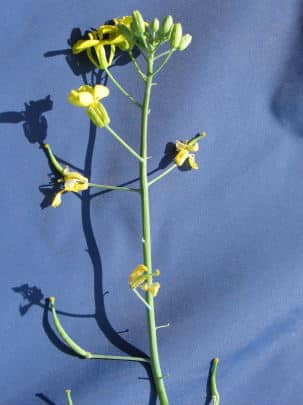
In 2010, Randy Kutcher, an AAFC research scientist at that time, analyzed the weather and yield data for 1967 to 2001 from 20 crop districts in Saskatchewan. He found that the number of days with highs of at least 31°C during the first 14 days of flowering had the highest impact on the canola yield.
Hot days cause canola plants to abort flowers. No flowers mean no pods and no yield. Even with a few days of heat, it can take a week for hormone balance and regular pod formation to return. The result is a long series of blanks on the stem where pods would normally form.
Agronomy tips:
—Seed early. An early established crop is more likely to avoid the hottest days of summer, which is one reason early-seeded crops tend to yield more.
—One Ontario study showed that a foliar boron application may improve flower retention in hot conditions, but the yield benefit was marginal. On the Prairies, an economic benefit from boron applied as a heat rescue treatment is unlikely. Read the Canola Digest article on micronutrients. See the Ultimate Canola Challenge boron results.
Mid-season moisture
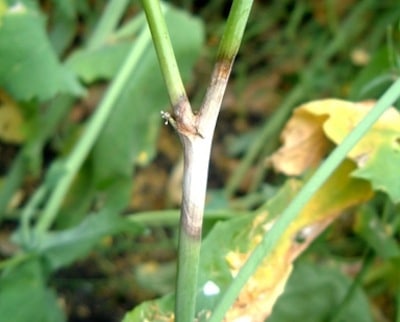
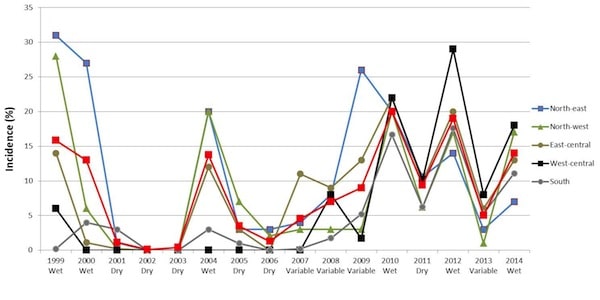
Moisture through the middle of the season provides a great boost to yield potential but it also greatly increases the risk of significant yield loss from sclerotinia stem rot. Moisture before flowering promotes the emergence of apothecia that release sclerotinia spores into the canola. Continued moisture through flowering will allow these spores to continue their lifecycle and infect canola.
Rishi Burlakoti, research lead and plant pathologist with Weather Innovations Consulting in Guelph, ON, says that with high rainfall during flowering in 1999, 2000, 2004 and 2009 in Saskatchewan, sclerotinia stem rot was found in the majority of the fields in provincial survey. “Heavy infection with sclerotinia stem rot can cause yield losses up to 50 percent,” Burlakoti says.
Agronomy tips:
—Apply fungicide. If moisture is present before and during flowering, fungicide is likely to provide a return on investment. Apply at 20% to 50% flower. Earlier in the window is usually better as early infection leads to the higher yield loss. Second applications may be warranted. Risk assessment. Long flowering and sclerotinia stem rot risk.
Hail
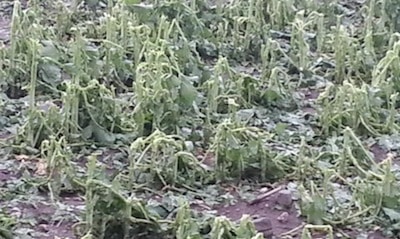
Hail caused 81 percent of loss claims for canola in Alberta in 2014, which is why almost all Alberta farmers with crop insurance also take the hail endorsement. In that same year, hail accounted for only 6.3 percent of crop insurance loss claims for canola in Saskatchewan and 5.3 percent for canola in Manitoba.
Agronomy tips:
—A plant stand of seven to 10 plants per square foot allows for some plant loss to early season hail while still maintaining full yield potential. Crop regrowth is possible, and recovery can be quite high when hail occurs in the first half of the season. Economic loss depends on crop stage.
—If a lot of leaf mass has been knocked of the plant, the nutrients in these leaves are unlikely to mineralize this crop year. So if crop recovery is strong, an in-crop nitrogen application can replace the nitrogen already taken up in this lost leaf mass. Results will be better if nitrogen supply was already low to moderate. Keep in mind that added nitrogen can also extend maturity, so consider the calendar date and crop stage with an eye on fall frost risk.
—Canola hailed at the 4- to 6-leaf stage can get more blackleg infection through damaged tissue. Fungicide might help, but only if you were considering using it in the first place. If the field was already at high risk of blackleg, hail damage increases that risk. If blackleg was not a major risk, fungicide probably won’t help much.
—Hail cannot cause sclerotinia stem rot and there is no evidence that this pathogen will enter plants directly through a hail wound, but hail at flowering can extend the flowering period, which extends the susceptible period for sclerotinia.
—An important step with hail damage at any time of the season is to call your hail insurance provider and keep them in the loop.
Early fall frost
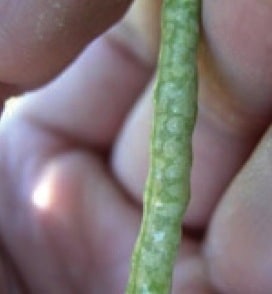
Frost that occurs before canola seeds have dried down to below 20 percent moisture and have cleared their chlorophyll will lead to yield and quality losses. These immature seeds will shrivel up and could be blown out of the combine, making no contribution to yield. And frost stops the chlorophyll-clearing process in canola seed permanently. High green counts are likely in fields that were not fully mature when heavy frost hits.
Agronomy tips:
—Seed earlier and at higher seeding rates. With more plants per square foot, a canola crop will mature more evenly and earlier.
—Choose varieties with days to maturity that match the typical growing season.
—Don’t be too hasty to swath. Swathing right after a light frost will probably lead to lower yield and quality than a crop left to mature completely. Leave the crop standing, but keep an eye on it. Check in the afternoon after a frost for wilting to make sure frost damage was not heavier than expected. Speckling on the stem and pods is may be of little concern, but check that seeds inside look OK and that pod integrity remains.
—Swathing because frost is in the forecast is usually the higher risk approach for canola that has not achieved at least 30 percent seed colour change on the main stem. If the frost is light or doesn’t occur at all, the risk to yield and quality from early swathing is high. Plus even if the risk is for a heavy frost, the opportunity to swath ahead of the frost may be lost: A heavy frost will lock in high green counts unless the crop has adequate dry down time to achieve a seed moisture of 20 percent or less. This can take three good drying days, so swathing has to occur at least three days before the frost to achieve this benefit.
Wind
Seedlings and harvest-ready crop are at greatest risk from wind damage. High winds can blow seeds and seedlings right out of the ground, especially if topsoil is dry. High winds can cause swaths to roll, and can increase shattering losses from canola left standing for straight combining.
Agronomy tips:
—Standing stubble can protect seedlings from wind damage.
—Wind can also delay weed control, which can have a large impact on yield. Because early spraying is so important, using a low-drift nozzle may be better than waiting longer for a relatively calm day suitable for a finer spray. Tips for spraying in wind.
—To reduce potential losses from swaths blowing, swath parallel to the typical prevailing winds in the area; cut plants as high as possible, just below the lowest pod; and roll the swath so the edges are nestled into the stubble.
—Crop left standing for straight combining tends to be a lower risk for wind loss if the crop is thick and well-knitted. Some varieties are also better than others, especially those with pod shatter reduction traits.

